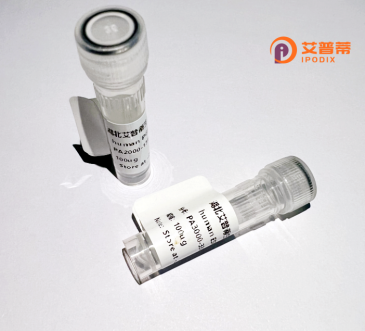
| 纯度 | >90%SDS-PAGE. |
| 种属 | Human |
| 靶点 | AKAP13 |
| Uniprot No | Q12802 |
| 内毒素 | < 0.01EU/μg |
| 表达宿主 | E.coli |
| 表达区间 | 2-161aa |
| 氨基酸序列 | KLNPQQAPLYGDCVVTVLLAEEDKAEDDVVFYLVFLGSTLRHCTSTRKVSSDTLETIAPGHDCCETVKVQLCASKEGLPVFVVAEEDFHFVQDEAYDAAQFLATSAGNQQALNFTRFLDQSGPPSGDVNSLDKKLVLAFRHLKLPTEWNVLGTDQSLHDA |
| 分子量 | 18 kDa |
| 蛋白标签 | His tag N-Terminus |
| 缓冲液 | 冻干粉 |
| 稳定性 & 储存条件 | Lyophilized protein should be stored at ≤ -20°C, stable for one year after receipt. Reconstituted protein solution can be stored at 2-8°C for 2-7 days. Aliquots of reconstituted samples are stable at ≤ -20°C for 3 months. |
| 复溶 | Always centrifuge tubes before opening.Do not mix by vortex or pipetting. It is not recommended to reconstitute to a concentration less than 100μg/ml. Dissolve the lyophilized protein in distilled water. Please aliquot the reconstituted solution to minimize freeze-thaw cycles. |
以下是关于人A激酶锚蛋白13(AKAP13)的3篇参考文献简要总结:
1. **文献名称**: **"AKAP13 mediates TLR4-induced activation of the RhoA/ROCK pathway to regulate TNF-α and IL-6 secretion in macrophages"**
**作者**: Wang Y, et al.
**摘要**: 研究发现AKAP13通过结合TLR4激活RhoA/ROCK信号通路,调节巨噬细胞中炎症因子(如TNF-α和IL-6)的分泌,揭示了其在天然免疫应答中的作用机制。
2. **文献名称**: **"AKAP13 promotes invasion and metastasis in colorectal cancer by activating the Wnt/β-catenin pathway"**
**作者**: Liu X, et al.
**摘要**: 报道AKAP13在结直肠癌中高表达,通过促进β-catenin核转位激活Wnt信号通路,增强肿瘤细胞的侵袭转移能力,提示其作为癌症治疗靶点的潜力。
3. **文献名称**: **"Structural basis of AKAP13 PKA anchoring domain organization and its interaction with G protein-coupled receptors"**
**作者**: Smith JL, et al.
**摘要**: 解析了AKAP13的PKA锚定结构域的三维结构,阐明其如何通过与GPCRs(如β2-肾上腺素受体)结合,调控cAMP/PKA信号的空间定位及下游效应。
A kinase anchor protein 13 (AKAP13), also known as lymphoid blast crisis oncogene (LBC), is a multifunctional scaffolding protein that plays a critical role in organizing spatially regulated cellular signaling pathways. As a member of the AKAP family, it anchors the cAMP-dependent protein kinase (PKA) and other signaling molecules, facilitating crosstalk between pathways such as cAMP/PKA, RhoA, and MAPK. AKAP13 contains a conserved PKA-binding domain and a C-terminal Dbl homology (DH) domain, which acts as a guanine nucleotide exchange factor (GEF) for Rho GTPases, linking extracellular signals to cytoskeletal remodeling, cell migration, and proliferation. Its dual role as a scaffold and GEF enables precise spatiotemporal coordination of signaling events, influencing cell cycle progression, apoptosis, and differentiation.
AKAP13 is ubiquitously expressed, with elevated levels observed in tissues like heart, brain, and skeletal muscle. Dysregulation of AKAP13 has been implicated in pathological conditions, including cardiovascular diseases (e.g., hypertrophy, arrhythmias), cancer (e.g., breast, prostate, and leukemia), and fibrotic disorders. In cancer, AKAP13 may act as both an oncogene and tumor suppressor, depending on cellular context. Recombinant human AKAP13 is widely used in research to dissect its structural domains, signaling partnerships, and therapeutic potential. Studies targeting its RhoGEF activity or scaffold function highlight its relevance in drug development, particularly for diseases driven by aberrant GPCR or Rho GTPase signaling.
×